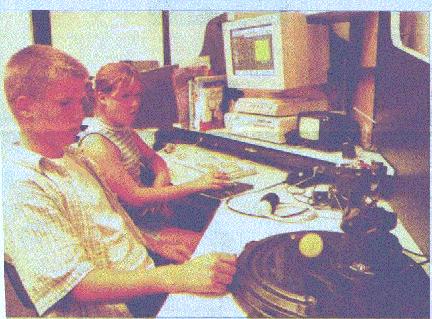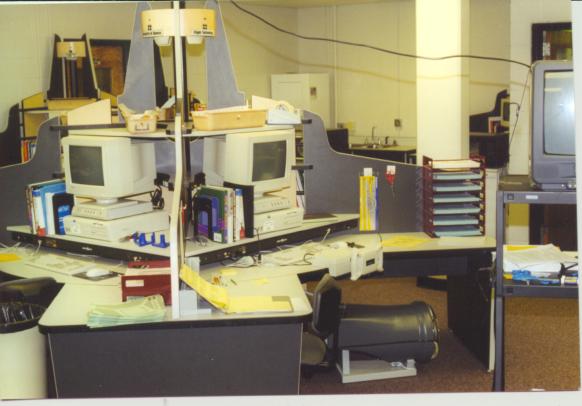.


Photo: Leavenworth TIMES
West students work at the robotics module.
The following story is reprinted from The Leavenworth TIMES, from the issue of September 14, 1999---
Copyright: The TIMES
---"West students learn about life"
By John Richmeier, Times Staff Writer
Two staples of school electives, shop and home economics were recently discontinued at West Middle School and replaced by a new course, life technology.
"(Life technology) is a program which prepares students for future jobs," said Gloria Carney, one of the course's teachers.
Carney formerly taught home economics at West Middle School. She is now teaching the first year of life technology with the school's former shop teacher, Richard Sheumaker.
The life technology classroom contains 21 computer workstations, or modules. These modules contain 23 different types of computer software. Two modules contain two software programs and the rest have only one.
Each software program has a theme and was designed to teach students about areas related to the theme.
The module themes include personal finance, baking and measurement, rocketry and space, flight technology, fitness and health, robots, audio broadcasting and video production.
The semester-long course can be taken by sixth, seven and eighth-grade students. Students in the course work at the modules in pairs of two. The groups are assigned at random by computer software.
Carney said it is important that students not pick their own partners.
"When you graduate and get a job, you don't have a choice in who you work with," she said.
Students work at each module for seven days. One semester covers seven modular lessons.
Students who take the course all three years of middle school will work at all 21 of the modules. Carney said a computer keeps track of which modules each student has taken so that no one will ever repeat one.
In addition to the computers and software, the class uses other equipment to help instruct the students, like a wind turbine which Sheumaker said works like a small wind tunnel, a robot arm named Sam, a solar oven and audio broadcasting equipment.
Equipment in shop and home economics classes, like a drill press and oven, is also incorporated into the new program. Students get the opportunity to bake, cook and build small rockets and wooden race cars.
Whenever students enter the class, they are supposed to check the scrolling message on an electronic message board. This board tells the students what session of the module they are supposed to work on. This method is used so the students can get to work immediately.
The computer software instructs students on assigned activities with words and audio and video recordings.
"This system really addresses every student's learning style," said Carney.
The software also quizzes students with problems relating to a module's theme, many of which require the use of math skills.
"Real life problems are what they're working with," said Carney.
If students have trouble answering the questions posed by the computer software, they can refer to supplemental textbooks.
"Math and reading are hidden in the modules," Carney said.
She said she and Sheumaker have had no trouble filling the class with students.
"It's fun," said 12-year-old Larry Tierney, who is enrolled in the class. "We don't have to write with our pencils."
"It's the best class in school," said Amber Sanderson, 11.
"It has different things," said Sheli Jones, 11. "Almost all of my other classes have the same thing."
Carney said if a student intentionally damages a piece of equipment, he or she is then out of the program. She said students are therefore very careful with the equipment because they do not want to be thrown out of the class.
"They respect the equipment just like its their very own," she said.
The curriculum and software used in the life technology class were designed by Synergistic Systems of Pittsburg, Kan.
Carney and Sheumaker said the Synergistic program was picked over similar programs after they saw how it worked in other schools.
"We went to seven or eight different schools and looked at their programs," Sheumaker said.
Carney said the district began looking for the right program to use two years ago, but said she had known about such programs long before that.
"We knew it was out there," she said. "I thought it was a dream, something that we would never get."
The program, costing $178,370, was paid for out of the district's capital outlay budget, a budget used to pay for improvements to district property, according to Catey Edwards, communications coordinator for Leavenworth public schools.
Carney said the expense was worth it.
"We expect the best from our kids, and we should give them the best," she said.
Carney and Sheumaker took a five-day training course to be able to teach the Synergistic program.
Carney said the computers and other equipment started coming into the classroom around July 1.
After their arrival, she and Sheumaker worked at learning the software every day for a month.
They said they are still learning the software, but are helped by Janet Hanson, the school's computer aide.
Sheumaker said he doesn't believe it would be possible for one person to teach the class.
"I cannot imagine one teacher doing this himself," he said.
Edwards said three smaller life technology classrooms will be put into the new Richard Warren Middle School, which is scheduled to be open at the start of the next school year.

WMS Photo